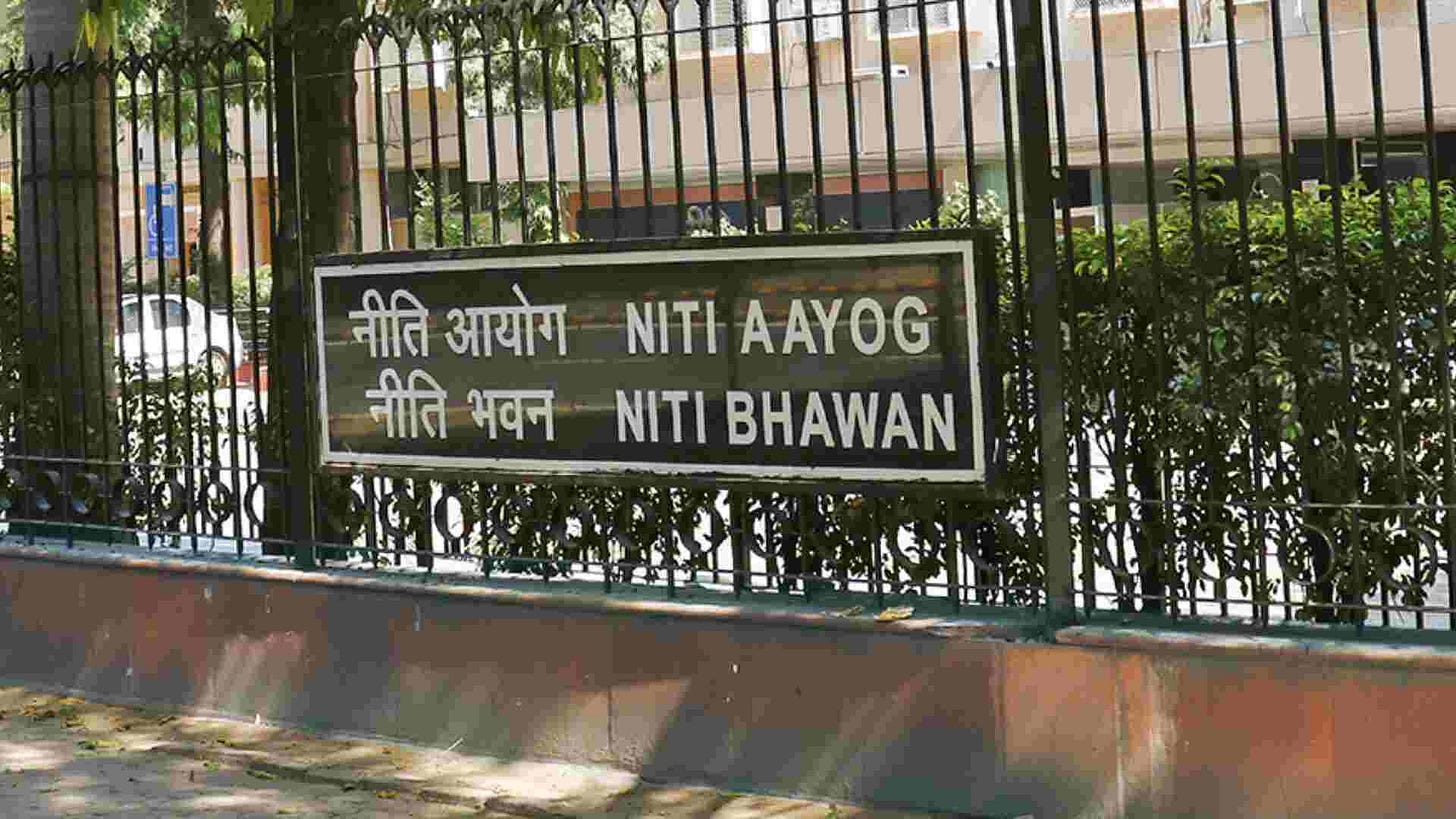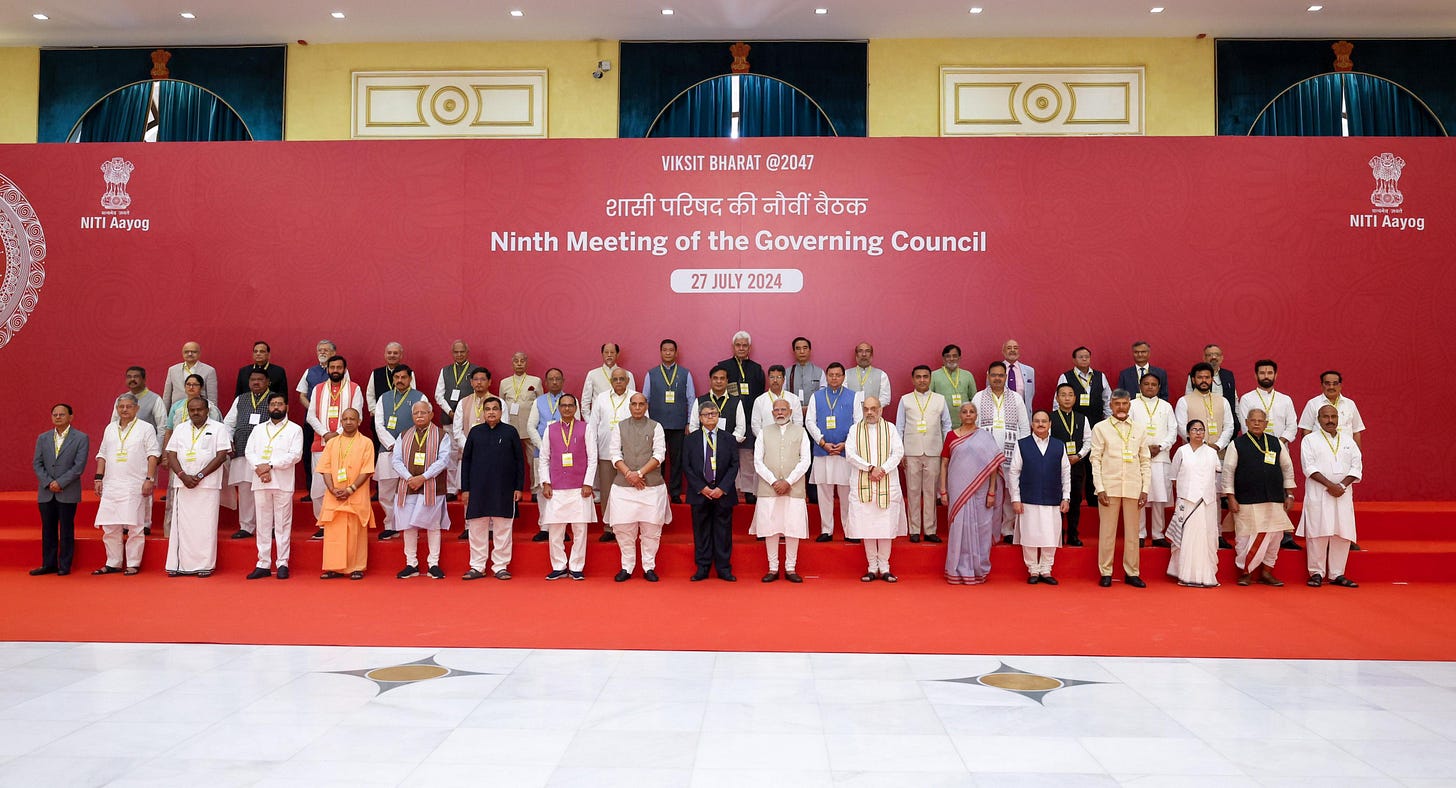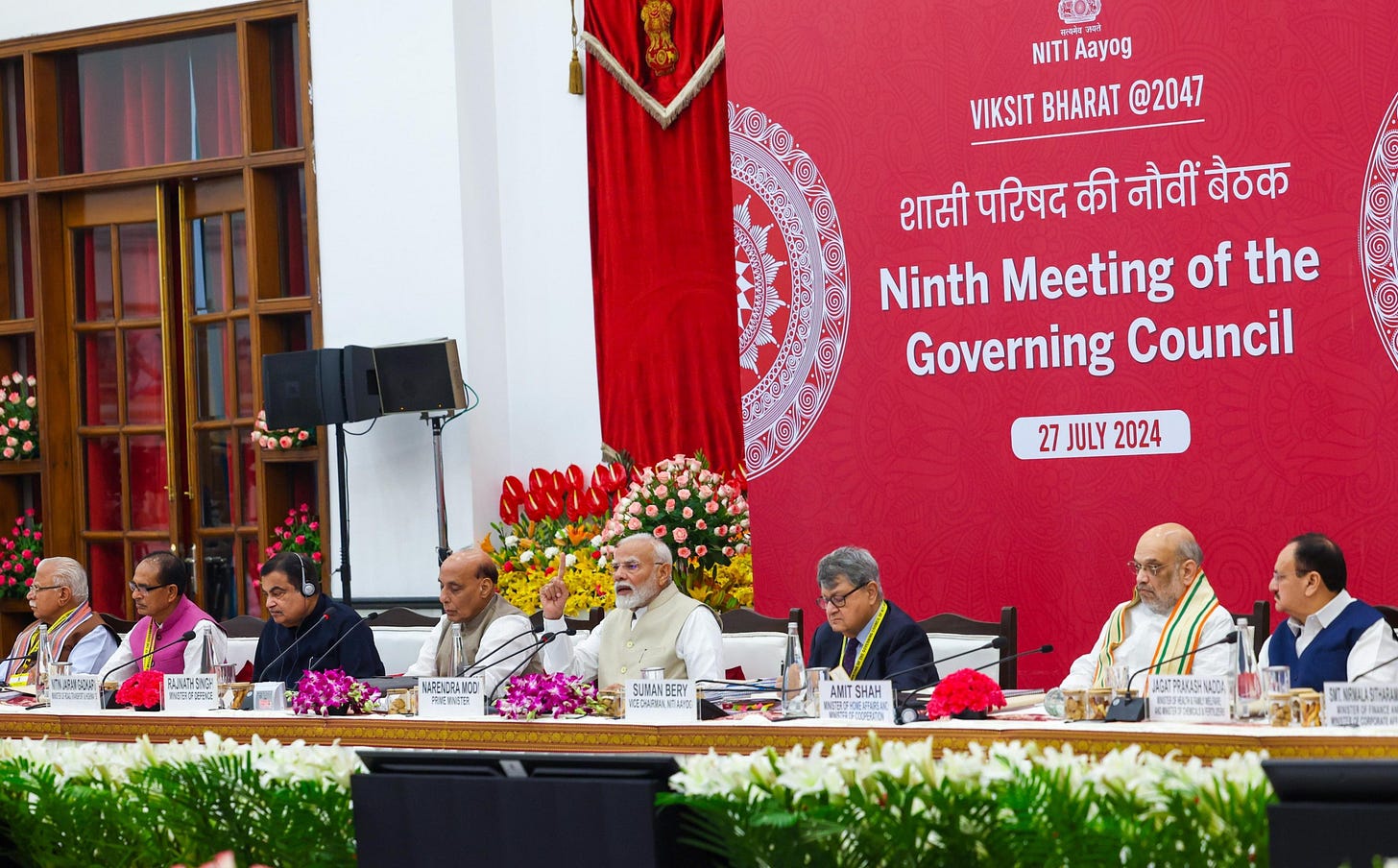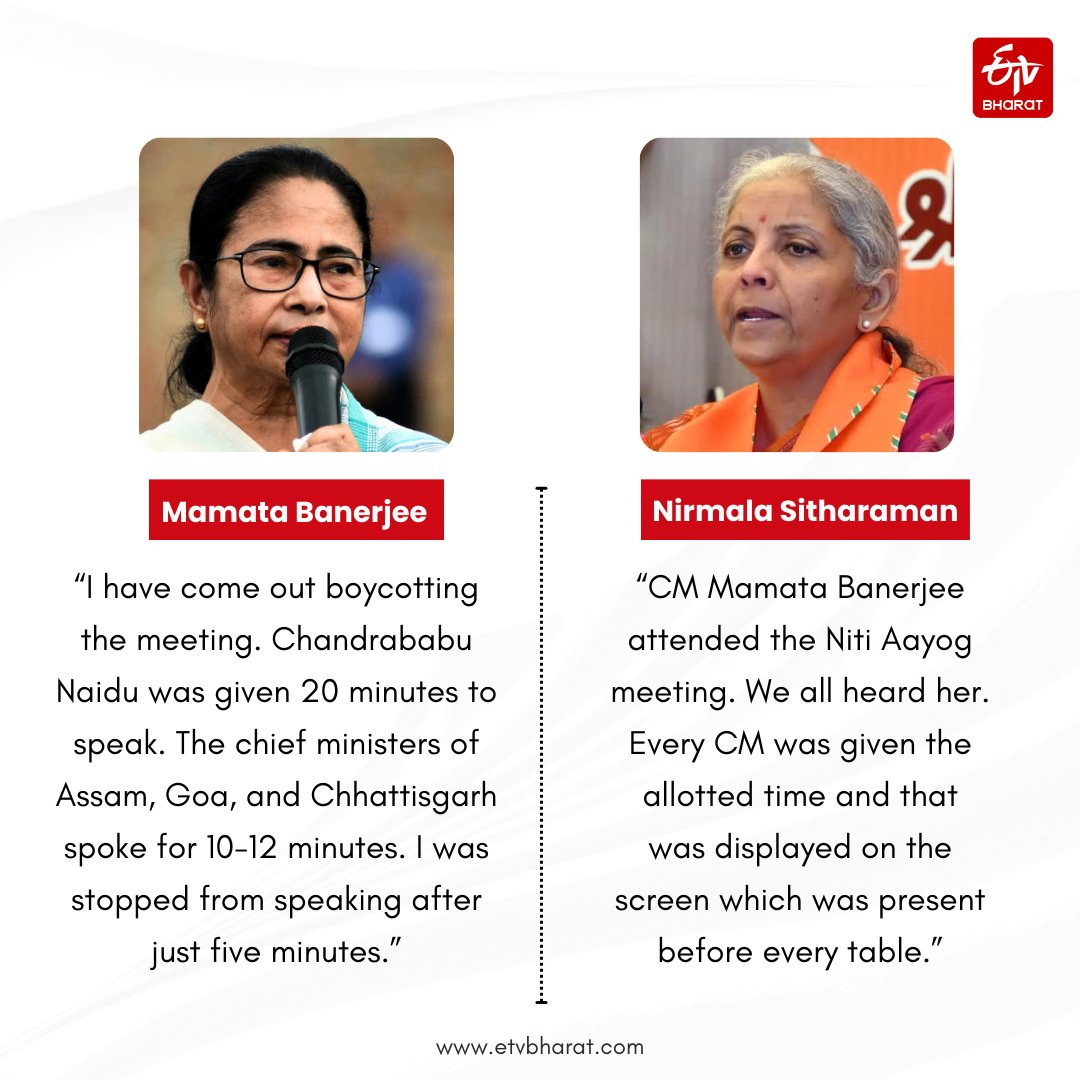Evaluating the NITI Aayog: Of Boycott, Babus, and Bonanza
Evaluating the Functions and Responsibilities of NITI Aayog vis-a-vis its predecessor the Planning Commission as well as the Central Finance Commission and the GST Council.
NITI Aayog in Focus
NITI Aayog has come under sharp focus following the decision by some opposition party-led state Chief Ministers to boycott the NITI Aayog meeting held on Saturday, 27th July, under the chairmanship of Prime Minister Narendra Modi. This boycott, which included all Congress Chief Ministers as well as those of Punjab and Tamil Nadu—but notably not the Chief Minister of West Bengal, who attended but subsequently walked out in protest—was widely articulated as a protest against the recent Union Budget presented by Finance Minister Nirmala Sitharaman. The dissenting states claimed that they were overlooked in favour of states like Bihar and Andhra Pradesh, led by the alliance partners of the NDA, whose support is crucial for the survival of the Modi 3.0 Government.
Prime Minister Narendra Modi, addressing the 9th Governing Council Meeting of NITI Aayog, emphasized that the ambition of "Viksit Bharat 2047" is a shared goal for every Indian. He highlighted that states play a crucial role in this vision as they are directly connected with the people, underscoring the importance of cooperative federalism and the collaborative efforts needed to achieve national development goals.
Examining the Scope and Efficacy of NITI Aayog
To appreciate the current controversy, it is essential to examine the overall role, functions, and responsibilities assigned to NITI Aayog, a non-statutory body. Comparing it with its predecessor, the Planning Commission (Yojana Aayog), as well as with other bodies within India's federal structure, such as the Central Finance Commission and the GST Council, provides valuable insights. This comparison helps us understand NITI Aayog's unique place in the governance framework as it highlights its collaborative and consultative approach to policy-making and assesses its efficacy in fostering cooperative federalism amidst an evolving political and economic landscape.
Functions and Responsibilities of NITI Aayog
The National Institution for Transforming India, commonly known as NITI Aayog, serves as the premier policy think tank for the Government of India. Established to foster a cooperative federal system and facilitate long-term strategic planning, NITI Aayog plays a critical role in the country's governance and development. While some view it as merely a rebranded Planning Commission (Yojana Aayog), its key functions and responsibilities highlight its unique contributions and distinct approach. Below are its primary functions and responsibilities:
1. Policy Formulation and Advisory Role
Premier Policy Think Tank: NITI Aayog serves as the main advisory body, providing strategic and technical advice on policy matters to both central and state governments.
Long-term Policy Frameworks: It designs and promotes long-term policy frameworks and initiatives, aligning them with the nation’s developmental goals.
2. Promoting Cooperative Federalism
Collaboration and Support: NITI Aayog fosters collaboration between the centre and states through structured support initiatives.
Common Platform for States: It provides a platform for states to work together in the national interest, promoting healthy competition among them (competitive federalism).
3. Sustainable Development Goals (SDGs)
Adoption and Monitoring: The Aayog oversees the adoption and monitoring of SDGs in India, ensuring their integration into national policies.
Goal Mapping: In collaboration with the Ministry of Statistics and Programme Implementation (MoSPI), it prepares mapping of goals and targets.
4. Monitoring and Evaluation
Program Implementation: NITI Aayog actively monitors and evaluates the implementation of various programs and initiatives.
Resource Identification: It identifies necessary resources to strengthen the probability of success and enhance the scope of delivery.
5. Innovation and Research Promotion
Support System: The Aayog creates a robust knowledge, innovation, and entrepreneurial support system.
Collaboration: It collaborates with national and international experts, practitioners, and partners to promote innovation.
Research Repository: NITI Aayog serves as a repository of research on good governance and best practices.
6. Inter-sectoral and Inter-departmental Coordination
Issue Resolution: It offers a platform for resolving inter-sectoral and inter-departmental issues.
Development Agenda: The Aayog accelerates the implementation of the development agenda by coordinating between different sectors and departments.
7. Village-level Planning
Plan Formulation: It develops mechanisms for credible plan formulation at the village level.
Plan Aggregation: These plans are progressively aggregated at higher levels of government for cohesive implementation.
8. Focus on Inclusive Growth
Attention to At-risk Sections: NITI Aayog pays special attention to sections of society at risk of not benefiting adequately from economic progress.
Balanced Development: It ensures inclusive growth and balanced development across the country.
9. Technology and Capacity Building
Technology Upgradation: Focuses on technology upgradation and capacity building for effective program implementation.
Driving Development: Fosters innovation and research to advance India's development agenda.
10. National Security Integration
Economic Strategy: Ensures that national security interests are incorporated into economic strategy and policy in specific areas.
NITI Aayog's diverse functions are carried out through various verticals and cells, including Agriculture, Education, Governance and Research, Infrastructure, Social Justice and Empowerment, among others. The organisation aims to be a dynamic platform that integrates expertise from various sectors to guide India's development process effectively.
Comparing NITI Aayog with the Planning Commission
The National Institution for Transforming India (NITI Aayog) was established in 2015 essentially to replace the Planning Commission (Yojana Aayog). This transition was purported to mark a significant shift in India's approach to governance and development planning. While the Planning Commission was responsible for creating Five-Year and Annual Plans, as well as approving specific schemes and projects, these functions have now been subsumed by the Ministry of Finance. This restructuring aims to increase administrative efficiency; however, it has arguably diminished the role of NITI Aayog, relegating it to a glorified "think tank" with merely advisory powers and no executive authority to approve projects or allocate funds. NITI Aayog thus primarily serves as merely an advisory body, focusing on providing strategic and technical advice on policy matters, whereas the Planning Commission had a more direct role in policy formulation, implementation and fund allocation.
The Shift from Centralized Planning to Cooperative Federalism
The approach of NITI Aayog emphasizes cooperative federalism by involving state governments in the policy-making process, in contrast to the Planning Commission's top-down blue-print approach, which often imposed policies on states. While the Planning Commission had the authority to allocate funds to state governments and central ministries, this responsibility now lies with the Finance Ministry under the current framework. NITI Aayog encourages active participation from state governments in policy formulation, unlike the Planning Commission, which limited their roles mainly to National Development Council meetings. Structurally, NITI Aayog features new positions such as CEO and Vice-Chairperson and includes part-time members, whereas the Planning Commission had full-time members, a member secretary, and a Deputy Chairperson.
NITI Aayog is an executive body not mentioned in the Constitution, while the Planning Commission also had an executive role but with a more established presence in governance. Focusing on long-term planning, policy innovation, and fostering partnerships, NITI Aayog contrasts with the Planning Commission, which was primarily focused on formulating and implementing Five-Year Plans. This shift from centralized planning to a more collaborative and advisory approach aims to make governance more responsive to the changing economic landscape and diverse needs of different states, fostering a more dynamic and inclusive framework for national development.
Comparison with other Institutions
Let us now compare the roles of NITI Aayog, Central Finance Commission, GST Council, and the Finance Ministry in allocating and devolving funds to states, under separate headings:
a.) NITI Aayog and the Central Finance Commission
NITI Aayog functions as an advisory think tank, providing strategic and technical advice on policy matters without direct fund allocation powers. In contrast, the Central Finance Commission is a constitutional body established under Article 280, tasked with recommending the distribution of net tax proceeds between the Centre and states, as well as principles governing grants-in-aid. While NITI Aayog's recommendations are non-binding, the Finance Commission's suggestions carry more weight, though not legally binding in the narrow sense of the term.
b.) NITI Aayog and the GST Council
The GST Council, another constitutional body, focuses specifically on GST-related matters, including tax rates and administration. Unlike NITI Aayog, whose role is advisory, the GST Council's decisions are generally accepted and implemented by both Centre and states. The Council meets regularly to address ongoing issues related to GST implementation and rates, ensuring a cooperative approach to indirect taxation across the country.
c.) NITI Aayog and the Finance Ministry
The Finance Ministry, particularly its Expenditure and Budget Divisions, is involved in day-to-day financial management and annual budget preparation. It implements the recommendations of the Central Finance Commission and manages the actual allocation of funds, including the so-called Plan funds, which were previously dealt with by the Planning Commission. While NITI Aayog doesn't directly allocate funds, it influences policy decisions that may impact resource allocation, working in tandem with the Finance Ministry to shape the nation's fiscal policies.
Boycott of NITI Aayog Serves No Useful Purpose
While the role of NITI Aayog may have diminished, it remains the nation's premier body for framing development policies and schemes to be implemented across the diverse country. It serves as an in-house standing consultant to the Government of India. However, critics, including Chief Ministers like Mamata Banerjee, argue that it might be better to revert to the model of the Planning Commission, where the annual plans of the states were discussed and approved through a bilateral mechanism. The new body is often perceived as a dumping ground for serving and retired bureaucrats, as well as armchair economists and academicians who may lack grassroots experience.
Despite these criticisms, the boycott of the NITI Aayog meeting chaired by Prime Minister Narendra Modi on 27th July would serve no useful purpose for the boycotting states, except perhaps capturing a media headline. Any issues regarding the Budget should be raised in Parliament rather than through political rhetoric in the context of NITI Aayog. This "Think Tank" may not be an ideal body, but it is essential to make optimal use of it within its constraining framework. When we talk of cooperative fiscal federalism, all the stakeholders must participate, in good faith.






Late Manohar Parrikar as chief minister of Goa upon assuming office for the first time desired to know from the officers as to the consequence of not participating in the Annual Plan (approval) discussions conducted by the erstwhile Planning Commision!
Would the (Gadgil-Mukherjee) formula based Normal Central Assistance admissible to Goa be denied to it? Would it stand to gain anything extra and in a substantial measure at that if it participates in the exercise? The answer to both the questions was a clear 'no' then and during the subsequent years as well.
Twenty years down the line there has been a sea change in the situation and in the equation. Even though the NITI Aayog may not have any power of approval or sanction of largesse to a state, yet the "boycott" of a meeting of the GC may have umpteen consequences for it!
However, it would not be as if on the issues concerning them, the boycotting states have not furnished their official (written) response to the items identified in the agenda for the meeting. It is only that the Chief Minister chose not to participate.
In a true spirit of real cooperative federalism, therefore, would it not be incumbent on the part of NITI Aayog to accommodate the symbolic "boycott" in good faith as well? 😊